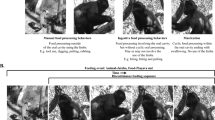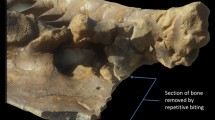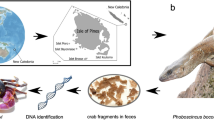Abstract
Beavers are well-known for their ability to fell large trees through gnawing. Yet, despite this impressive behavior, little information exists on their masticatory musculature or the biomechanics of their jaw movements. It was hypothesized that beavers would have a highly efficient arrangement of the masticatory apparatus, and that gnawing efficiency would be maintained at large gape. The head of an American beaver, Castor canadensis, was dissected to reveal the masticatory musculature. Muscle origins and insertions were noted, the muscles were weighed and fiber lengths measured. Physiological cross-sectional areas were determined, and along with the muscle vectors, were used to calculate the length of the muscle moment arms, the maximum incisor bite force, and the proportion of the bite force projected along the long axis of the lower incisor, at occlusion and 30° gape. Compared to other sciuromorph rodents, the American beaver was found to have large superficial masseter and temporalis muscles, but a relatively smaller anterior deep masseter. The incisor bite force calculated for the beaver (550–740 N) was much higher than would be predicted from body mass or incisor dimensions. This is not a result of the mechanical advantage of the muscles, which is lower than most other sciuromorphs, but is likely related to the very high percentage (>96 %) of bite force directed along the lower incisor long axis. The morphology of the skull, mandible and jaw-closing muscles enable the beaver to produce a very effective and efficient bite, which has permitted beavers to become highly successful ecosystem engineers.



Similar content being viewed by others
References
Ball SS, Roth VL (1995) Jaw muscles of New World squirrels. J Morphol 224: 265–291
Blanga-Kanfi S, Miranda H, Penn O, Pupko T, DeBry RW, Huchon D (2009) Rodent phylogeny revised: analysis of six nuclear genes from all major rodent clades. BMC Evol Biol 9: 71
Brandt JF (1855) Beiträge zur nähern Kenntniss der Säugethiere Russlands. Mém Acad Imp Sci St Pétersbourg, Sér 6 9: 1–375
Caspari E (2003) Animal Life in Nature, Myth and Dreams. Chiron Publications, Hendersonville, NC
Cox PG, Jeffery N (2011) Reviewing the morphology of the jaw-closing musculature in squirrels, rats and guinea pigs with contrast-enhanced microCT. Anat Rec 294: 915–928
Cox PG, Kirkham J, Herrel A (2013) Masticatory biomechanics of the Laotian rock rat, Laonastes aenigmamus, and the function of the zygomaticomandibularis muscle. PeerJ 1: e160
Cox PG, Rayfield EJ, Fagan MJ, Herrel A, Pataky TC, Jeffery N (2012) Functional evolution of the feeding system in rodents. PLoS ONE 7: e36299
Druzinsky RE (2010a) Functional anatomy of incisal biting in Aplodontia rufa and sciuromorph rodents – Part 1: Masticatory muscles, skull shape and digging. Cells Tissues Organs 191: 510–522
Druzinsky RE (2010b) Functional anatomy of incisal biting in Aplodontia rufa and sciuromorph rodents – Part 2: Sciuromorphy is efficacious for production of force at the incisors. Cells Tissues Organs 192: 50–63
Druzinsky RE (2015) The oral apparatus of rodents: variations on the theme of a gnawing machine. In: Cox PG, Hautier L (eds) Evolution of the Rodents: Advances in Phylogeny, Functional Morphology and Development. Cambridge University Press, Cambridge, pp 323–349
Fabre P-H, Hautier L, Dimitrov D, Douzery EJP (2012) A glimpse on the pattern of rodent diversification: a phylogenetic approach. BMC Evol Biol 12: 88
Freeman PW, Lemen CA (2008) A simple morphological predictor of bite force in rodents. J Zool 275: 418–422
Herrel A, Spithoven L, Van Damme R, De Vree F (1999) Sexual dimorphism of head size in Gallotia galloti: testing the niche divergence hypothesis by functional analyses. Funct Ecol 13: 289–297
Jenkins SH, Busher PE (1979) Castor canadensis. Mammal Species 120: 1–8
Johnston CA, Naiman RJ (1990) Browse selection by beaver: effects on riparian forest composition. Can J Forest Res 20: 1036–1043
Korth WW (2002) Comments on the systematics and classification of the beavers (Rodentia, Castoridae). J Mammal Evol 8: 279–296
Müller-Schwarze D (2011) The Beaver: Its Life and Impact. 2nd Edition. Cornell University Press, Ithaca and London
Murphy RA, Beardsley AC (1974) Mechanical properties of the cat soleus muscle in situ. Am J Physiol 227: 1008–1013
Naiman RJ, Melillo JM, Hobbie JE (1986) Ecosystem alteration of boreal forest streams by beaver (Castor canadensis). Ecology 67: 1254–1269
Naiman RJ, Pinay G, Johnston CA, Pastor J (1994) Beaver influences on the long-term biogeochemical characteristics of boreal forest drainage networks. Ecology 75: 905–921
Nowak R (1999) Walker’s Mammals of the World. Johns Hopkins Press, Baltimore
Offermans M, De Vree F (1989) Morphology of the masticatory apparatus in the springhare, Pedetes capensis. J Mammal 70: 701–711
Osborn JW (1969) Dentine hardness and incisor wear in the beaver (Castor fiber). Cells Tissues Organs 72: 123–132
Rosell F, Boysér O, Collen P, Parker H (2005) Ecological impact of beavers Castor fiber and Castor canadensis and their ability to modify ecosystems. Mammal Rev 35: 248–276
Rybczynski N (2007) Castorid phylogenetics: implications for the evolution of swimming and tree-exploitation in beavers. J Mammal Evol 14: 1–35
Rybczynski N (2008) Woodcutting behavior in beavers (Castoridae, Rodentia): estimating ecological performance in a modern and fossil taxon. Paleobiology 34: 389–402
Schneider CA, Rasband WS, Eliceiri KW (2012) NIH Image to ImageJ: 25 years of image analysis. Nat Methods 9: 671–675
Simpson GG (1945) The principles of classification and a classification of mammals. Bull Am Mus Nat Hist 85: 1–350
Terwilliger J, Pastor J (1999) Small mammals, ectomycorrhizae, and conifer succession in beaver meadows. Oikos 85: 83–94
Thorington RW, Darrow K (1996) Jaw muscles of Old World squirrels. J Morphol 230: 145–165
Tullberg T (1899) Über das System der Nagethiere: eine phylogenetische Studie. Nova Acta Reg Soc Sci Upsala Ser 3 18: 1–514
Turnbull WD (1970) Mammalian masticatory apparatus. Fieldiana (Geol) 18: 147–356
van Spronsen PH, Weijs WA, Valk J, Prahl-Andersen B, van Ginkel FC (1989) Comparison of jaw-muscle bite-force cross-sections obtained by means of magnetic resonance imaging and high-resolution CT scanning. J Dent Res 68: 1765–1770
Waterhouse GR (1839) Observations on the Rodentia with a view to point out groups as indicated by the structure of the crania in this order of mammals. Ann Mag Nat Hist 3: 90–96, 184–188, 274–279, 593–600
Wood AE (1965) Grades and clades among rodents. Evolution 19: 115–130
Woods CA (1972) Comparative myology of jaw, hyoid, and pectoral appendicular regions of New and Old World hystricomorph rodents. Bull Am Mus Nat Hist 147: 115–198
Woods CA, Hermanson JW (1985) Myology of hystricognath rodents: an analysis of form, function and phylogeny. In: Luckett WP, Hartenberger J-L (eds) Evolutionary Relationships among Rodents: A Multidisciplinary Analysis. Plenum Press, New York, pp 685–712
Woods CA, Howland EB (1979) Adaptive radiation of capromyid rodents: anatomy of the masticatory apparatus. J Mammal 60: 95–116
Wright JP, Jones CG, Flecker AS (2002) An ecosystem engineer, the beaver, increases species richness at the landscape scale. Oecologia 132: 96–101
Acknowledgments
The authors thank Dr Andrew Kitchener of National Museums Scotland for providing the beaver specimen, and Mrs Sue Taft from the Department of Engineering, University of Hull for use of her dermestid beetle colony. Thanks are also due to Gwen Haley and the staff of the X-ray department at The York Hospital for CT scanning the skull and mandible. We are grateful to two anonymous reviewers for their helpful comments.
Author information
Authors and Affiliations
Corresponding author
Electronic supplementary material
Below is the link to the electronic supplementary material.
Online Resource 1
Mathematical details of the calculation of the biomechanical metrics. (DOCX 26 kb)
Rights and permissions
About this article
Cite this article
Cox, P.G., Baverstock, H. Masticatory Muscle Anatomy and Feeding Efficiency of the American Beaver, Castor canadensis (Rodentia, Castoridae). J Mammal Evol 23, 191–200 (2016). https://doi.org/10.1007/s10914-015-9306-9
Published:
Issue Date:
DOI: https://doi.org/10.1007/s10914-015-9306-9




